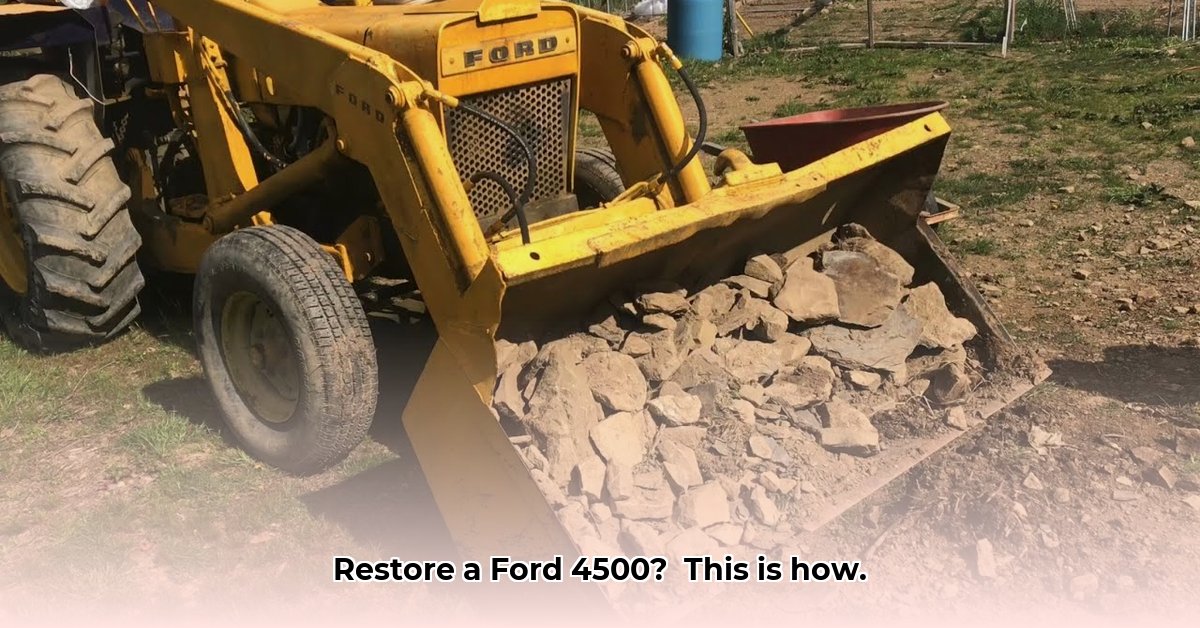
The Ford 4500 industrial tractor, produced between 1965 and 1975, holds a significant place in agricultural and industrial history. Its robust design and versatility made it a beloved workhorse for generations. This guide serves as a comprehensive resource for collectors, restorers, and enthusiasts seeking to understand, maintain, and restore this iconic machine. Whether you're a seasoned mechanic or a curious newcomer, you'll find valuable information here. For more on Ford tractors, check out this helpful resource.
A Legacy of Power: The Ford 4500's History and Significance
The Ford 4500 wasn't just another tractor; it was a symbol of reliable power and versatility. Its rugged build and adaptable design made it a favorite among farmers and construction workers alike. This tractor could handle a surprising range of tasks, from plowing fields to hauling heavy materials, thanks to its adaptable three-point hitch system. Its relative simplicity, compared to modern tractors, also contributed to its enduring popularity. Many view restoring a Ford 4500 as a way to reconnect with a simpler, more mechanically intuitive era of machinery. Isn't restoring a piece of history incredibly satisfying?
Decoding the 4500: Technical Specifications and Variations
Understanding the Ford 4500's technical specifications is crucial for both operation and restoration. Several engine and transmission options were available, leading to variations in horsepower, torque, and fuel consumption. This section details these variations to help you identify your specific model. This knowledge forms the bedrock of any successful restoration project. What are the key differences between the available engine options?
The Ford 4500 offered two primary engine choices:
| Engine Type | Displacement (liters) | Horsepower (approx.) | Torque (lb-ft) (approx.) | Fuel Type | Transmission Options |
|---|---|---|---|---|---|
| Three-Cylinder Diesel | 3.3 | 55-57 | 150-180 | Diesel | 6-speed manual, 4-speed power shuttle |
| Three-Cylinder Gasoline | 3.1 | 58-59 | 160-190 | Gasoline | 6-speed manual, 10-speed full power shift |
(Note: Approximate figures vary depending on model year and condition. Consult your owner's manual for precise specifications.)
Keeping it Running: Operation and Preventative Maintenance
Before embarking on a restoration, understanding the tractor's operation and maintenance is key. Regular lubrication, fluid checks, and preventative maintenance are essential for longevity. Addressing minor issues promptly prevents larger, more costly problems later. What are the most common issues encountered by Ford 4500 owners?
Key Maintenance Tasks:
- Regular Oil Changes: Follow the manufacturer's recommended oil change intervals.
- Fluid Level Checks: Regularly check levels of engine oil, transmission fluid, coolant, and hydraulic fluid.
- Lubrication: Lubricate all moving parts according to the maintenance schedule.
- Tire Pressure: Maintain proper tire inflation for optimal performance and safety.
- Belt Inspection: Regularly check belts for wear and tear.
Resurrecting a Legend: A Step-by-Step Restoration Guide
Restoring a Ford 4500 is a rewarding but challenging undertaking. This comprehensive guide breaks the process into manageable steps. This detailed plan is designed to ensure you are empowered to approach this iconic tractor's restoration with confidence.
Phase 1: Assessment and Planning:
- Thorough Inspection: Carefully examine the tractor's condition, documenting damage and missing parts.
- Parts Inventory: Compile a complete list of necessary parts and supplies.
- Prioritization: Determine which repairs are essential for functionality and safety.
Phase 2: Component Restoration:
- Engine: If needed, undertake a complete engine overhaul, including cleaning, part replacement, and testing.
- Transmission: Inspect and repair or replace damaged components within the transmission.
- Hydraulic System: Flush and inspect the hydraulic system, replacing damaged seals and lines as needed.
- Bodywork: Address rust, dents, and other cosmetic issues through repair or replacement.
Phase 3: Reassembly and Testing:
- Careful Reassembly: Reassemble the tractor, ensuring that all components are properly aligned and secured.
- System Testing: Test all systems (engine, transmission, hydraulics, etc.) to ensure proper functionality.
- Final Inspection: Perform a final inspection, addressing any remaining issues.
The Parts Puzzle: Sourcing Components for Your Restoration
Finding replacement parts for a vintage tractor can be a challenge. However, several avenues exist to locate the components you need. What are the best strategies for identifying rare or hard-to-find parts?
Key Resources for Parts:
- Online Forums: Connect with other Ford 4500 enthusiasts online for advice and parts leads.
- Specialty Tractor Parts Suppliers: Several companies specialize in supplying parts for vintage tractors.
- Salvage Yards: Search salvage yards for used parts.
- Online Auction Sites: Look for parts on auction sites like eBay.
Community and Resources: Connecting with Fellow Enthusiasts
Joining online forums and clubs dedicated to Ford tractors provides access to invaluable resources. Fellow enthusiasts share experiences, tips, and parts leads, creating a supportive community. What are some of the most popular online resources for Ford 4500 enthusiasts?
Valuable Resources:
- MyTractorForum
- [Your State/Regional Tractor Club] (Search locally)
This comprehensive guide provides a structured approach to restoring a Ford 4500, blending historical context with practical, step-by-step instructions. Remember, patience and perseverance are key to a successful restoration. By following these guidelines and leveraging available resources, you can bring this legendary tractor back to its former glory, preserving a piece of agricultural and industrial history for future generations.